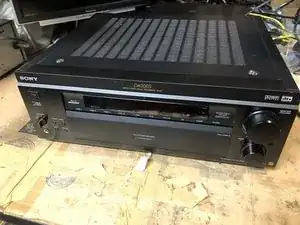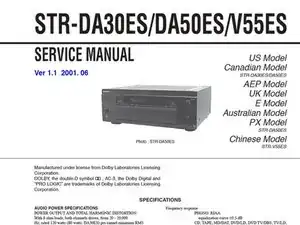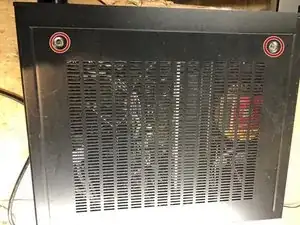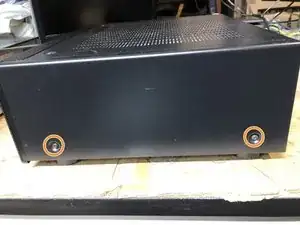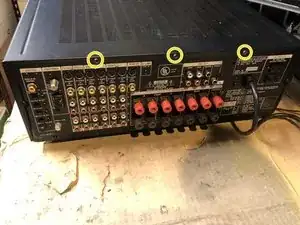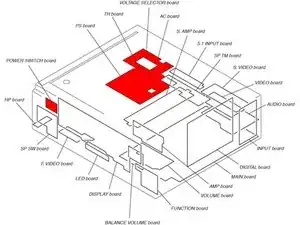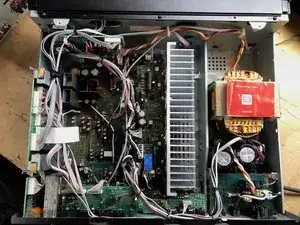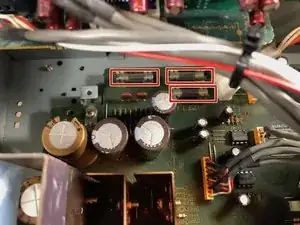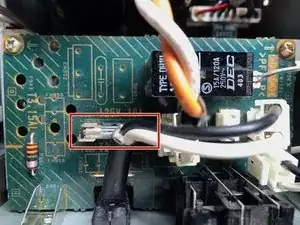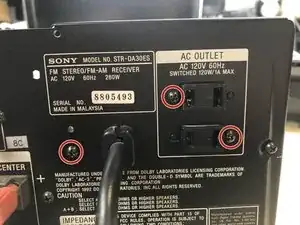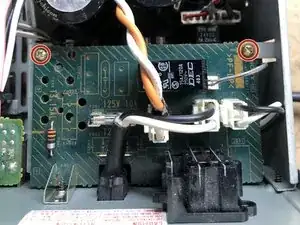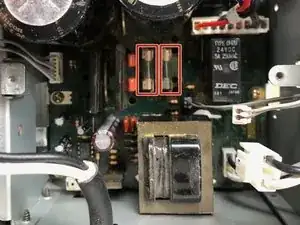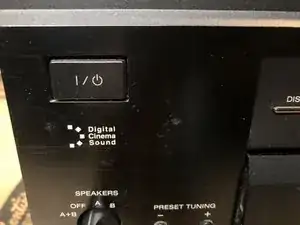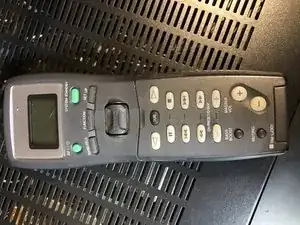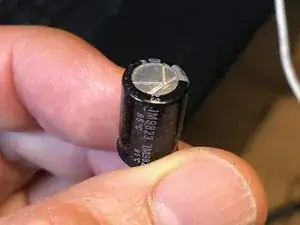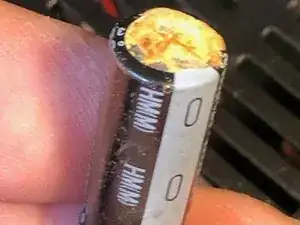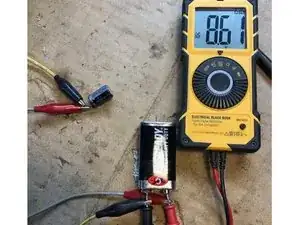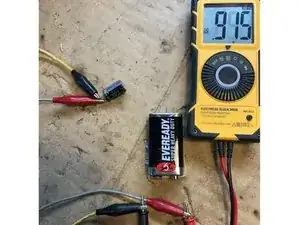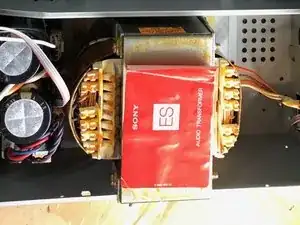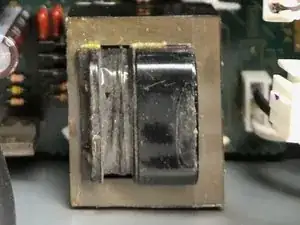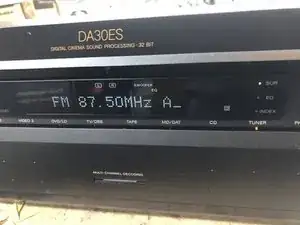Einleitung
I was offered a Sony STR-DA30ES surround sound receiver that would not power on. That seemed like a pretty straightforward project that might require finding faulty components on circuit boards and replacing them. I have limited experience with this kind of repair, so I took it on the theory that I might learn something useful. As a reward, if successful I would end up with a working receiver.
Werkzeuge
-
-
To do this kind of repair, you usually need circuit diagrams to guide your work. These are sometimes found in the operating manual, but are more likely to be found in a product service manual.
-
Documents for many products are available online for free, even for fairly old items like this receiver.
-
In this case, I lucked out because the manufacturer web site had the operating manual as well as the service manual.
-
If the manufacturer doesn't provide a service manual, you can sometimes find one on the web. Some sites want you to pay or install their software to download the manual; I avoid these because they might be scams. Others want your email address so they can SPAM you, but you can always block them once you get what you want.
-
-
-
To avoid a potentially deadly electrical shock, make sure that the device has been unplugged before opening the case. The large power supply capacitors can hold a lethal charge; it is a good idea to wait 10 minutes or more for any charge on the big capacitors to leak away before proceeding to open the case.
-
9 Phillips screws hold down the top case cover:
-
Two are on the top.
-
Two are on each side.
-
Three are along the top rear of the case.
-
Once these screws are removed, gently pull to spread the bottom edges of the top case.
-
Lift and slide rearward to remove the case top.
-
-
-
This Sony receiver has a large number of circuit boards. The service manual has a diagram showing their identities and locations.
-
Because the unit won't power on, we're going to focus on the PS (Power Supply) board and the AC board.
-
Another thing to identify as a potential problem is the power switch, which has its own small circuit board behind the front panel of the receiver.
-
-
-
When you open the case of a broken device, look for clues for where the problem lies. If you know what to look for, signs of trouble may be obvious.
-
If you smell a burning smell, that could indicate that a failed component has overheated. Look for any component that smells burnt or is discolored (usually brown or black). That component, or others wired to it, could be the source of the problem.
-
Also look at the circuit boards themselves. Brown discoloration could be caused by failed, overheating components that you will need to replace.
-
Check for electrolytic capacitors that are swollen or popped. These are usually small metal cylinders that have deep scribe lines on their tops; when they fail, they may pop open along the scribe lines. Electrolytic fluid may leak out and stain the circuit board.
-
-
-
This receiver has a lot of fuses. Best to check them all. Fuses blow to protect circuits from short circuits that would otherwise cause major damage. Sometimes they blow for some transient reason, and replacing them fixes the problem.
-
There are three fuses on the large main board, in the upper left corner (when at the back of the device looking toward the back of the front panel).
-
Use your multimeter to see if the fuse is blown. Set the meter to Continuity and touch the probes to the two metal ends of the fuse. Your meter should beep to indicate that the fuse is still good.
-
If your meter doesn't beep, then the fuse is blown. Replace the fuse with one of identical rating, reassemble the device, plug it in and turn on the power. If it works, you're done. If it blows again, you will have to look for the cause of the short circuit.
-
-
-
There is one fuse on the AC Board, which is the small circuit board where the power cord enters the device. Check the fuse for continuity as before.
-
Note: A non-US version of this product may have different power supply circuitry.
-
-
-
You must remove the AC Board to inspect the Power Supply board underneath it. It is held in place by 5 screws.
-
Three screws are on the outside of the case. One is to the left of the power cord. The other two are on either side of the switched AC outlets.
-
The final two screws are on the corners of the AC Board.
-
After you remove the screws, detach the four external cables. Release the latch on the three large connectors, by pinching the top of the connector, then pull straight up. From left to right the connectors are:
-
the connector with orange and white wires
-
the connector with the black and white wires coming from the power cord
-
the small connector
-
the connector with the black and white wires taking AC power to the PS Board.
-
-
-
There are two fuses on the PS (Power Supply) Board, which is underneath the AC Board. Check the fuses for continuity as before.
-
-
-
The power switch is in the upper left corner of the front panel. If you do some disassembly you can access the power switch circuit board. Use your continuity checker to confirm that the power switch works properly.
-
Unlike older electronics that I am familiar with, AC power does not pass through this power switch. Instead, pressing the Power button sends a signal to a chip that turns on the receiver.
-
The power switch circuit board is a little tricky to get to. As an alternative, if you happen to have the IR remote control that goes with the Sony Receiver, just press the power button on the remote. If the unit powers up by remote but not the front panel switch, then the front panel power switch must be bad.
-
If the unit fails to power up with the remote, then the failure could be due to the remote, or it could be something else.
-
-
-
Carefully examine all electrolytic capacitors for leaks or bulges. Feel the tops of the capacitors. If you see the slightest leak or bulge, you should test the capacitor. To test a component, you often need to remove it from its circuit board.
-
The top of this small capacitor on the PS Board looked flat, but it felt slightly pointy where all the etched lines converge, when I ran my finger over the top. It was subtle, but it indicated to me that the component was going bad. The leaky capacitor in the second photo is not from this unit, but I added it so you can see what one looks like.
-
To remove a capacitor (really, any component) from a circuit board for testing, you will have to first remove the circuit board from the unit. For the PS Board, disconnect the various connectors. Remove six Phillips screws. If the board won't come out, you may have to first remove the giant power transformer that is held by four Phillips screws.
-
TIP: If you have any doubts about remembering where the cables go, take some photos before you start unplugging things.
-
To remove an electrolytic capacitor for testing, first note its orientation on the board. One of the two capacitor leads will be marked with large minus signs. Take care to put it (or its replacement) back in the same orientation.
-
Unsolder the capacitor from the circuit board. Use a low wattage pencil soldering iron to heat the solder on the reverse side of the circuit board. When the solder is molten, use a solder sucker to remove the solder.
-
If this doesn't work too well, gently pull on the capacitor while applying heat. Work one lead and then the other, rocking back and forth, until the capacitor comes free.
-
WARNING: Don't pull too hard, or you might damage the circuit board.
-
-
-
When you find a suspect electrolytic capacitor, test it. If it is okay, solder it back in the same orientation. If it is bad, replace it with another with the same capacitance and voltage rating.
-
How do you test it? Some multimeters have a "Capacitance" setting. If like me yours does not, you can still proceed with the test. Switch your multimeter to DC volts. Attach the red probe to the "+" terminal of the capacitor. Attach the black probe to the "-" terminal.
-
Next, use alligator clips to connect a 9-volt battery to the capacitor, again observing polarity: the "+" battery terminal goes to the "+" terminal on the capacitor, and the "-" terminal on the battery goes to "-" on the capacitor.
-
Carefully note how long it takes the capacitor to charge up to 9 volts.
-
Disconnect the battery and note how long it takes the capacitor to discharge. Compare the charge and discharge times to a known good capacitor with identical specifications. If there is a significant difference in charge or discharge time, then replace the capacitor.
-
In my case, the old capacitor discharged twenty times faster than a new one. I concluded that the receiver's problem was a bad capacitor.
-
Your unit may have a bad diode, transistor, or something else. Search the web for a guide on how to test each type of component.
-
-
-
If all else fails, study the circuit diagrams in the Service Manual.
-
Focusing on the power supply, I probed around and confirmed that AC voltage was getting to only some of the places where it was needed. In particular, it was not getting to the inputs of the giant transformer with the orange "Sony ES" label.
-
Power was not passing through a power relay. The relay is activated by a chip, when the user pushes the power switch. Wait a minute, if the relay needs power to turn on the power supply, then what powers the relay?
-
Once I asked that question, I figured out that this Sony receiver has a small power supply with a small transformer, that provided standby power even when the unit is off. When the power button gets pressed, standby power activates the power relay, which sends power to the giant power transformer that runs the Sony receiver's powerful amplifier.
-
Knowing this, you can proceed to check the Standby power supply. It should be producing DC power any time the Sony receiver is plugged in (i.e. even before you push the Power button).
-
-
-
After replacing a bad component, reassemble the receiver, plug it in, and turn it on to see if it works.
-
If it works, declare victory. If not, then continue looking for bad components.
-
You can apply these simple techniques to a device of any size.
Ein Kommentar
Muchas gracias. 👍👏.
